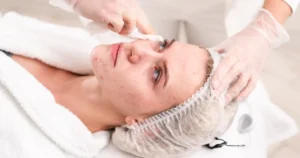
- HOME
- ABOUT
- SKIN
- BODY
- FACE
- EQUIPMENT
- POST PROCEDURE
- CONTACT US
- IPAL ACADEMY
- IPAL SMILE STUDIO
- HOME
- ABOUT
- SKIN
- BODY
- FACE
- EQUIPMENT
- POST PROCEDURE
- CONTACT US
- IPAL ACADEMY
- IPAL SMILE STUDIO
DERMATITIS: THE SKIN IRRITATION
admin
January 26, 2023

Overview
Dermatitis is the scientific name of skin irritation. Dermatitis is a general condition that has many causes and occurs in many forms. It includes itching, dry skin, a rash, swelling, or redness. Or it may cause blisters on the skin, or sores, oozing, peeling, and breakage of the skin. Examples of this condition include atopic dermatitis (eczema), dandruff, and contact dermatitis.
Skin infections are not contagious, but they can make you uncomfortable and lack self-confidence. Moisturizing regularly helps control symptoms. Ointments, creams, and shampoos should be used as a treatment.
Species
- Atopic dermatitis (eczema)
- Contact dermatitis
- Seborrheic dermatitis
- Rash from the diaper
- Cradle cap
Symptoms
Each type of dermatitis may look somewhat different, and they can affect different parts of your body. Signs and symptoms of different types of dermatitis include:
Atopic dermatitis (eczema): Usually, it begins in childhood, and this red, itchy rash is common between folds of skin – on the elbows, behind the knees, and in the front of the neck. When it is scratched, fluid may leak from the rash, and a crust may form. People with atopic dermatitis (eczema) may get better and then flare up seasonally.
Contact dermatitis: This red, stinging, and itchy rash occur when the skin comes into contact with substances that are irritating or allergic. Blisters may form.
Seborrheic dermatitis: This condition causes scaly patches, red skin, and chronic dandruff. It usually affects oily areas of the body, such as the face, upper chest, and back. Seborrheic dermatitis can last for a long time, with periods of improvement then seasonal flare-ups. Cradle cap is a specialist term used in terms of infant disease.
Follicular eczema: In this type, the affected skin thickens and hair follicle bumps develop. The condition is common in African Americans and in people with dark brown skin.
When to see the skin specialist
Please Consult the skin specialist in the following cases:
- If you experience discomfort due to insomnia or a lack of focus in your daily routine.
- If you feel pain in the skin
- If you suspect that your skin is infected
- You try self-care steps and signs and symptoms persist
The reasons
Is your sting a plant?
Causes of the most common types of dermatitis include:
Atopic dermatitis (eczema): This type of dermatitis is most likely related to dry skin, genetic variation, immune system malfunction, skin infection, exposure to or contact with allergens, whether food or airborne materials or a combination of these factors.
Contact dermatitis: This condition results from coming into contact with something that irritates your skin or causes an allergic reaction. Irritants or allergens include poison ivy, perfumes, nickel-plated jewelry, cleansers, and preservatives found in many creams and lotions.
Seborrheic dermatitis: This condition may be caused by a yeast fungus found in the sebum.
Risk factors
Dermatitis risk factors include:
Age: Dermatitis can occur at any age, but atopic dermatitis (eczema) usually begins in early childhood.
Allergy and asthma: People with a personal or family history that includes eczema, allergies, hay fever, or asthma are more likely to develop atopic dermatitis.
Occupation: Jobs that put you in contact with certain metals, solvents, or cleaning materials increase your risk of developing contact dermatitis.
Health conditions: Your risk of developing seborrheic dermatitis may increase if you have certain health conditions, such as congestive heart failure, Parkinson’s disease, and HIV / AIDS.
Complications
The scratchy, itchy rash associated with atopic dermatitis may cause open sores, which can become infected. Dermatitis infections can spread and be life-threatening in rare cases.
Protection
Be sure to wear protective clothing when performing a task that involves the use of irritants or caustic chemicals.
Avoid dry skin by following these habits when you shower:
Take a shower or bath in no time: Limit bathing or bathing time to 5 to 10 minutes. Use warm water instead of hot. An oil bath may also be helpful.
Use a mild, non-soapy cleanser: Choose non-soap detergents that are free of added fragrance. Some types of soap can dry out the skin.
Dry your body gently: After taking shower, dry your skin with a soft towel.
Moisturize your skin: While your skin is still damp, moisturize it with an oil, cream, or moisturizer. Try different types of products until you find the one that works for you. Ideally, the right product for you will be safe, effective, fragrance-free, and affordable. Two small studies showed that applying a protective moisturizer to the skin of infants at high risk of developing atopic dermatitis reduced the incidence of the condition by up to 50 percent.
Recent Posts



Have Any Question?
- +92-347-0008397
- [email protected]

